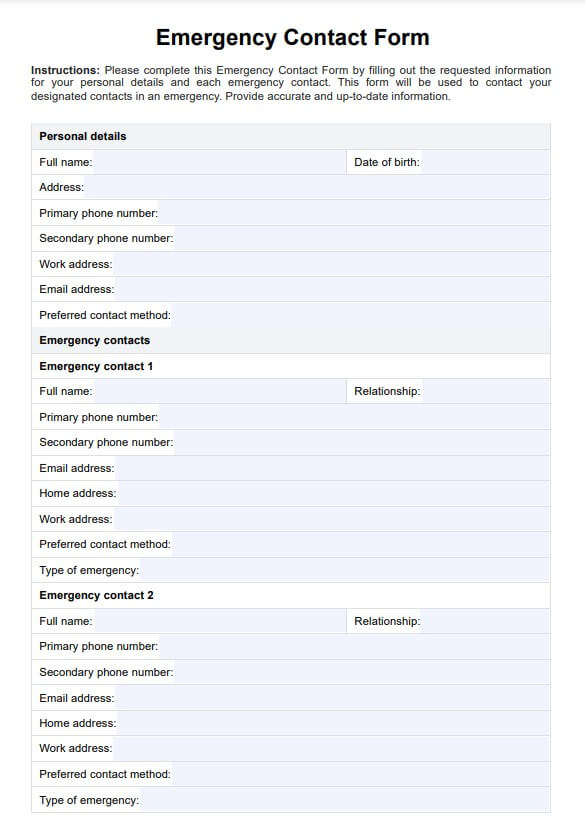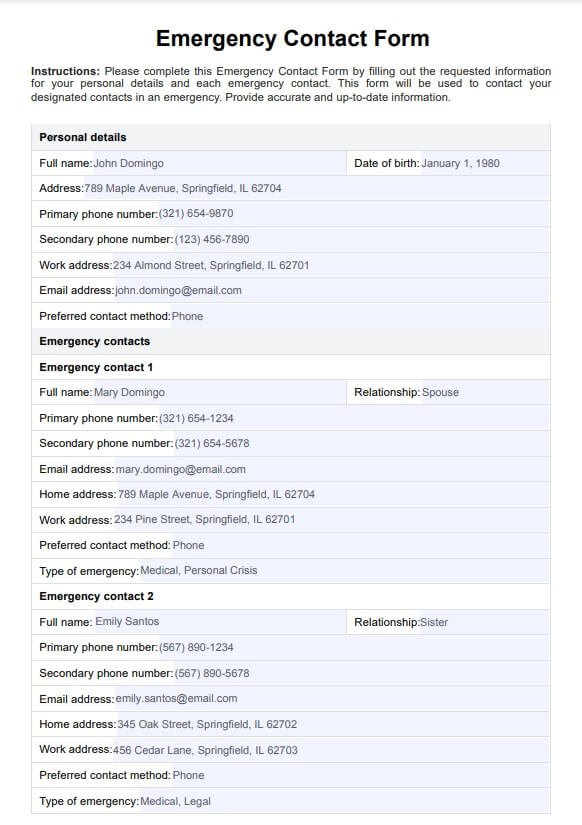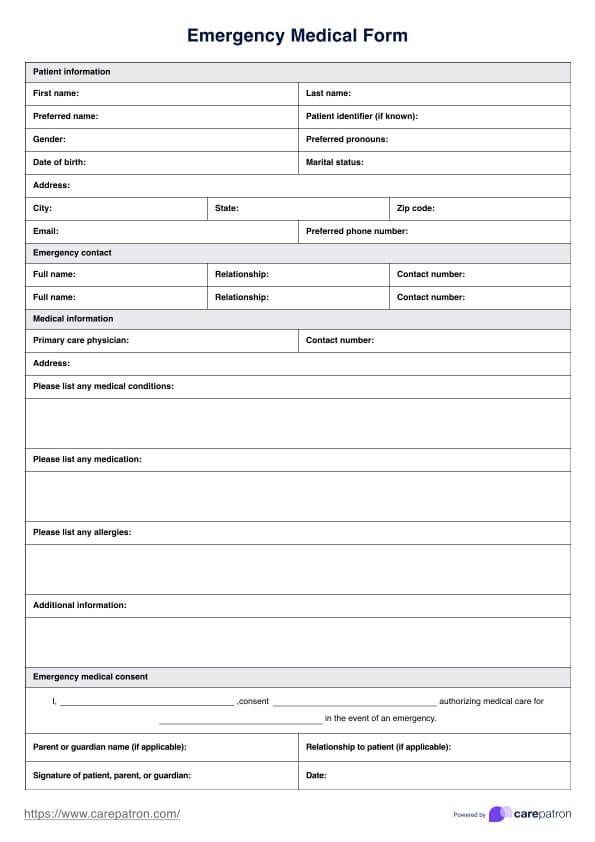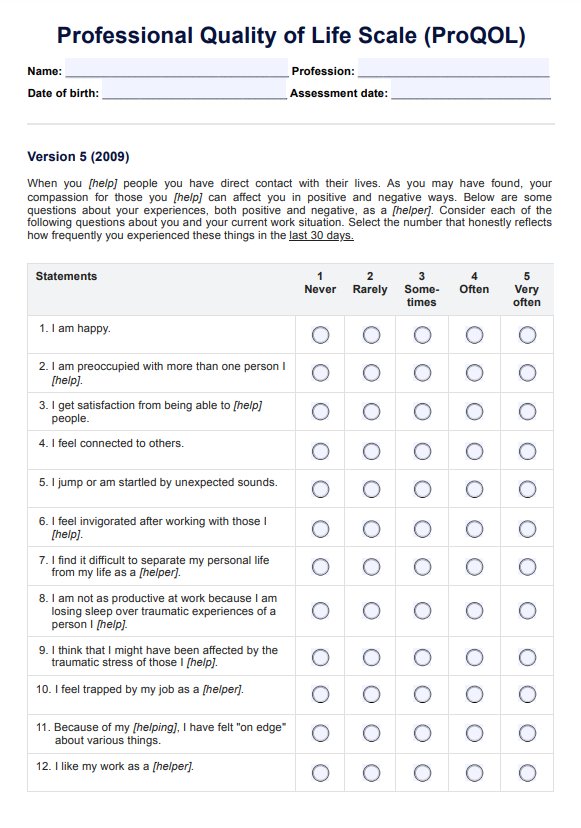Emergency Contact Form
Help your patients stay prepared and organized when an emergency occurs with our Emergency Contact Form. Download for free today!


What is an emergency contact?
In emergencies where the victim needs immediate medical assistance, a primary emergency contact is valuable. Having this crucial information could save lives. In 2019, injuries worldwide led to 4.4 million deaths, making up 8% of all deaths. In 2018, the Disease Control Priorities Project pointed out that providing better emergency care could significantly reduce deaths and disabilities in low and middle-income countries (World Health Organization, n.d.).
An emergency contact is designated to be contacted in an emergency or crisis. This individual should be someone the individual trusts, knowledgeable about basic information, medical conditions, and preferences, and able to provide reliable support during difficult situations. Emergency contacts may be family members, friends, neighbors, or even coworkers, but the critical factor is their ability to respond quickly and effectively when someone needs emergency services.
Emergency Contact Form Template
Emergency Contact Form Example
What is an Emergency Contact Form?
An Emergency Contact Form is a vital document containing comprehensive information about these designated individuals, ensuring their details are readily accessible in a single, organized location.
The emergency contact format typically includes the following information:
- Emergency contact details: This consists of the emergency contact's full name, primary and secondary phone numbers, and email address. Providing multiple means of communication increases the chances of reaching your contact during an emergency. It is helpful to provide a secondary emergency contact person, too.
- Relationship: Specifying the connection to the emergency contact (e.g., spouse, parent, friend) helps responders understand the contact's relevance and potential role in decision-making or support. Having multiple emergency contact relationship options can be beneficial.
- Preferred contact method: Indicating the preferred method of communication (phone, text, email, or any other) ensures that the emergency contact can be reached most effectively and conveniently.
- Type of emergencies: Listing the types of emergencies for which the contact should be notified (medical, fire, natural disaster, personal crisis, or other) helps streamline the communication process and involve the correct individuals in specific situations.
- Addresses: Including your emergency contact's home and work addresses of the emergency contact allows responders or support personnel to locate them if needed, especially in situations where phone or email communication is not possible.
In short, emergency contact forms serve as a reference point for emergency responders to quickly identify and contact the appropriate contacts when time is of the essence.
How does this printable Emergency Contact Form work?
Understanding the importance of being prepared for emergencies is crucial, and having a well-organized emergency medical contact form can make all the difference in such situations. Our printable Emergency Contact Form template is designed to help your client compile and store essential information about their designated contacts in a clear and easily accessible format. Follow the steps below:
Step 1: Download the form
You can download the Emergency Contact Form template from the link on this page. Depending on the number of emergency contacts they wish to designate, you may instruct your clients to print as many copies of the form as they need. Check out our Emergency Contact Form sample for reference.
Step 2: Fill out the form
Provide the required information. It must be accurate and up-to-date information for emergency contacts, including their name, relationships, phone numbers, email addresses, home and work addresses, preferred contact methods, and the types of emergencies they should be contacted for.
Step 3: Share the form
Instruct them to share the form with their emergency contacts. Ensure their designated contacts know their role and provide them with a copy of the filled-out form for their reference.
Step 4: Store for future use
Store the completed form in a safe and accessible location. Keep the form where it can be easily found during a medical emergency, such as in a folder or binder with other necessary documents.
When to use the Emergency Contact Form?
An Emergency Contact Form should be used in various situations where having a readily accessible and organized document containing your designated contacts' information is vital. These situations include:
- Managing medical emergencies: A medical Emergency Contact Form allows quick notification of designated contacts and informed decision-making by medical professionals regarding patients with known medical conditions or allergies.
- Workplace emergencies: At work, an employee Emergency Contact Form can be used to easily contact an employee's family member when an emergency occurs, like a workplace accident. The document also is a form of protection for both the employee and the company.
- Traveling: Facilitate assistance in case of accidents or lost documents while traveling, particularly in unfamiliar locations or abroad. This offers peace of mind for both patients and their companions.
- Caring for children and aging relatives: Provide essential information to caretakers or school officials for prompt communication with designated contacts during an emergency involving children or aging family members.
- Responding to natural disasters or large-scale emergencies: Enable emergency responders or relief organizations to swiftly reach designated contacts for coordination and support during earthquakes, floods, or hurricanes.
- Addressing personal crises: Support friends, family members, or support professionals in offering assistance and guidance during personal crises, such as mental health emergencies, financial hardships, or legal troubles, through readily available contact information.
In all these situations, the Emergency Contact Form templates ensure that your patient's vital contact information is well-organized, easy to access, and available.
Benefits of using this form
The emergency contact information form is valuable for everyone, from families and caretakers to schools, employers, and travelers, ensuring quick communication during emergencies. It helps maintain organized, up-to-date contact information, making it easier to reach the right people when needed. Here's how it can benefit healthcare professionals like you:
Quick access to emergency contacts
Medical professionals can immediately reach a patient's emergency contact, which is crucial during urgent situations, especially when confirming some medical details. This helps ensure that the patient's family or caregivers are informed promptly of the important details and medical care provided.
Easy communication
An organized list of contacts makes it easier for healthcare providers to connect with the right person. This reduces delays in getting necessary approvals or sharing important health updates.
Better patient support
With contact information readily available, medical professionals can quickly coordinate care with a patient's support network. This collaboration enhances the overall care and recovery process.
Reference
World Health Organization. (n.d.). Emergency care saves lives. https://www.who.int/initiatives/emergency-care-saves-lives
Commonly asked questions
To use the Emergency Contact Form, download and print the template, fill in the required information for each emergency contact, and store the completed form in a safe and easily accessible location. Be sure to provide a copy to your designated contacts, so they know their role and have the necessary information.
The Emergency Contact Form should be stored in an easily accessible and secure location. Consider keeping the form in a folder or binder with other necessary documents, such as insurance policies and medical records. It is also a good idea to have a digital backup of the form, either on your device or in a cloud-based storage service, to ensure you have access to the information in case the physical copy is lost or damaged.
A responder should inform emergency contacts promptly and empathetically, providing clear and concise information about the situation and the individual's condition while offering reassurance and guidance on the next steps if necessary.










































































































